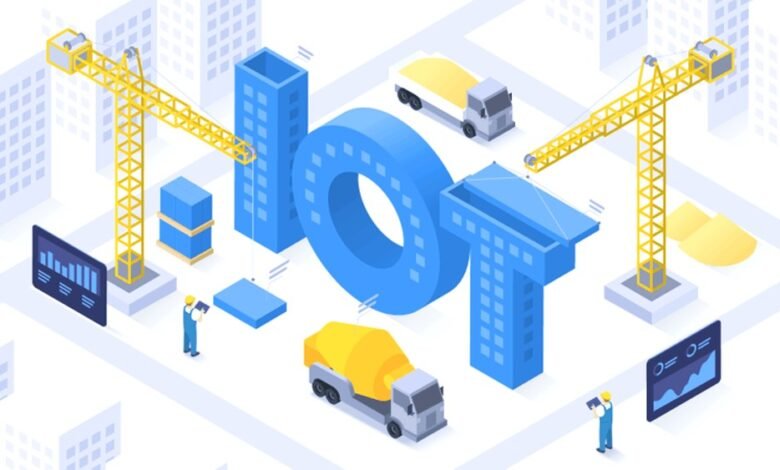How IoT is Affecting Construction Jobsites

Construction companies prioritize timely and cost-effective project completion. However, the lack of workers and rising costs of materials make it more difficult to achieve this goal. Despite the industry’s historically sluggish adoption of technology, an increasing number of companies are utilizing data-driven, IoT-enabled intelligence tools to address these challenges on construction job sites. Between 2020 and 2022, the AEC tech industry experienced an 85% increase in investments as a result of this demand.
The industry has begun to recognize that the more urgent incorporation of technology is necessary to improve the protection of individuals, mitigate risk, manage assets, and optimize workflows. We should investigate the potential of IoT solutions to assist architects in overcoming the obstacles they face and achieving superior project results.
Read More: 18 Industrial IoT Applications Their Benefits
IoT-enabled safety solutions make the industry more attractive
Safety risk is one of the primary factors that discourages individuals from pursuing employment in the construction industry, as it is responsible for approximately one in five workplace fatalities. To exacerbate the situation, construction teams are susceptible to additional risks when they are understaffed.
Although safety is acknowledged as a critical concern by construction leaders, it is also susceptible to being disregarded in the midst of the demands of a typical workday. It is difficult to supervise the numerous laborers who arrive and depart from each location. In order to maintain stringent safety protocols, construction managers must depend on their teams, partners, and third-party contractors. This risk can be mitigated by providing managers with real-time information regarding the status of labor sites through the use of IoT technologies.
Safety managers, project managers, and company leadership are provided with continuous visibility into the site’s activities through construction job site intelligence software that is based on IoT-enabled cameras. Self-contained cameras are effortless to install and operate, and they enable construction leaders to monitor real-time events from a single URL, whether through a website browser or embedded within a comprehensive project management platform. Additionally, these platforms can provide them with the ability to access recordings, which will enable them to evaluate practices, investigate incidents, and reduce potential risks.
Additionally, ubiquitous devices, including smart watches, facilitate the monitoring of worker health. They issue notifications to employees when they begin to overexert themselves or when external conditions, such as excessive heat, become too hazardous. By linking this data to the company’s job site intelligence platform, management’s understanding of the situation is significantly improved. They can verify the data and subsequently determine the most suitable course of action. For example, it is possible that employees can more effectively utilize a machine to reduce physical strain. Alternately, management may modify protocols and reassign responsibilities as required.
Construction companies can reduce jobsite risk and increase their appeal to potential employees by integrating IoT solutions to support site safety.
Protecting Jobsites with IoT-Enabled Security Solutions
The construction industry has consistently faced the challenge of construction larceny, which results in annual losses ranging from $400 million to $1 billion. Nevertheless, the cost of replacing stolen equipment has become considerably higher—tthe cost of new equipment has increased by over 20% since pre-pandemic years. Theft and vandalism can also result in substantial delays to a project’s remediation or replacement of materials. It is surprising that construction managers are on high alert due to the threat of vandalism, larceny, and tampering. In the majority of cases, the implementation of a comprehensive security plan is necessary to secure the appropriate builder’s risk insurance coverage. IoT technologies provide assistance in this regard.
Construction jobsites cameras have been transformed into site intelligence tools as a result of advancements in IoT technology. They are designed for site surveillance and are now equipped with talk-down capabilities to deter unauthorized visitors. Real-time, personalized audio messages, such as “Step away from the excavator and leave the site” or “You in the red shirt are trespassing; exit immediately,” can be transmitted by the monitoring team. This serves to discourage visitors and reduces the likelihood of damage.
Enhancing Equipment Security
The installation of IoT-enabled sensors on construction equipment allows administrators to monitor the status and location of tools through the job site intelligence platform. In the event of a security breach, they can promptly identify the equipment that was compromised and submit an insurance claim. They can also verify this information using visual data from work site cameras. This documentation and validation not only assist managers in the oversight of multiple sites simultaneously, but it also expedites the resolution process in the event of a security threat.
Future-oriented, the integration of visual intelligence and sensor technologies expedites the process of resuming projects after an incident. It may even serve to mitigate the occurrence of incidents. For instance, an item of equipment is identified as having departed the site. The contractors can automatically locate that moment in time and ascertain the events that transpired by utilizing the 24/7 video feeds from a job site intelligence camera solution and the timestamp. If the equipment is stolen, it can be used as evidence to submit a claim and can verify whether it was moved correctly or incorrectly. It monitors activity in and around the job site and alerts the appropriate parties when incidents necessitate attention.
Using IoT to Improve Project Outcomes
In addition to assisting construction companies in achieving their primary objective of delivering efficient projects, the Internet of Things (IoT) can also assist in addressing some of the challenges associated with the labor shortage and increasing material costs. In 2022, labor inefficiencies resulted in a loss of more than $30 billion for U.S. contractors. On a job site, there are many moving parts, which can hinder productivity in a variety of ways. By integrating digital, IoT-enabled tools, construction managers can gain a more comprehensive understanding of project activity, enabling them to make more informed decisions and optimize operations.
Project Outcomes in Action
For example, construction managers can monitor the progress of a complete portfolio of job sites in real time by utilizing site intelligence solutions that utilize IoT-enabled cameras. They can readily identify which workflows are fostering productivity and which are hindering it, and they can manage with a comprehensive 360-degree view. Managers can prioritize their time, thereby averting the necessity of incurring fuel costs and travel time to each site. This is the most advantageous feature. They can efficiently verify that the work is being completed in a timely manner, within the designated budget, and to the highest quality standards. They have the ability to prioritize their workday as necessary and be efficient with their time.
Similarly, the utilization of sensors in construction machinery facilitates the monitoring of equipment status. In this manner, teams can identify the necessity for repairs and resolve them prior to the occurrence of substantial delay. By incorporating this data into their job site intelligence platform, they can monitor the status of all repairs from a single, central location. They can also review their camera feeds to determine whether a piece of equipment was damaged as a result of improper operation and to schedule additional employee training if necessary.
Additionally, IoT-enabled sensors can assist teams in the efficient location of necessary tools by tracking equipment, utilizing the 360-degree view provided by their job site intelligence platform. In this manner, they allocate more time to achieving project objectives and less time to exploring the entire site for specific equipment.
An IoT-Enabled Construction Future
The market for architecture, engineering, and construction technology experienced a threefold increase in value between 2017 and 2022. Although the construction industry is confronted with a talent scarcity and increasing material prices, it is also on the brink of a substantial technological transformation. IoT solutions will be instrumental in assisting construction companies in the optimization of productivity on job sites and the delivery of more efficient project outcomes.











